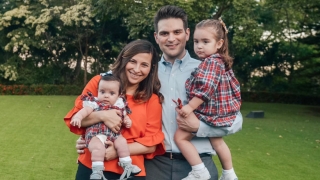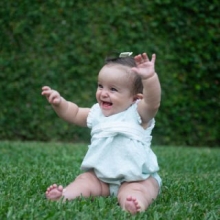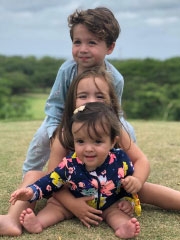From Central America to Philadelphia for Fetal Surgery for Spina Bifida: Eva’s Story
Published on
Published on
The distance between Managua, Nicaragua, and Philadelphia is 3,632 miles. But for Adriana and Carlos, the journey from their Central American home to Children’s Hospital of Philadelphia was measured in moments of hope, periods of uncertainty, and ultimately, arrival at a much longed-for destination. Now 18 months old, their daughter Eva is happy, active and thriving.
 Eva's family traveled from Nicaragua for fetal surgery at CHOP.
Twelve weeks into her second pregnancy, Adriana was scheduled for a routine ultrasound. Very quickly, the routine became the unthinkable. Her physician identified an anomaly in the unborn baby’s back, which he diagnosed as myelomeningocele (MMC), the most common and severe form of spina bifida. Adriana was stunned.
Eva's family traveled from Nicaragua for fetal surgery at CHOP.
Twelve weeks into her second pregnancy, Adriana was scheduled for a routine ultrasound. Very quickly, the routine became the unthinkable. Her physician identified an anomaly in the unborn baby’s back, which he diagnosed as myelomeningocele (MMC), the most common and severe form of spina bifida. Adriana was stunned.
As she tried to process the news, her doctor explained that treatment options within Nicaragua were limited. Even the country’s most skilled neurosurgeon performed the traditional postnatal repair of MMC only about once a year. The doctor counseled Adriana and her husband Carlos to seek care internationally. He also mentioned the possibility of fetal surgery, but Adriana initially dismissed the idea: “It sounded too experimental to us.”
As the shock of their diagnosis subsided, the couple began to research treatment options in the United States. “Regardless of the sadness we felt, we knew we had to begin taking action,” Adriana says. It was in the process of reading articles and watching videos about MMC online that Carlos found MOMS.
The Management of Myelomeningocele Study (MOMS), published in 2011 in the New England Journal of Medicine, showed that operating on a baby in the womb can result in better outcomes than traditional repair, which usually takes place a few days after birth. Fetal surgery outcomes included improved neurologic function and better chances of the child being able to walk independently.
The landmark study was co-led by Children’s Hospital of Philadelphia (CHOP), whose team members had pioneered the surgical procedure. Since the study, CHOP’s Center for Fetal Diagnosis and Treatment has performed nearly 400 fetal surgeries for MMC, the most experience of any program in the world.
“Carlos read all the results,” says Adriana, “and that convinced us they were the experts to trust.” They decided to contact CHOP’s Center for Fetal Diagnosis and Treatment (CFDT).
 Eva underwent prenatal surgery for myelomeningocele before she was born.
The center team answered Adriana’s inquiry the very same day. “I was so happy we got such a quick response,” she says. “It changed our lives.”
Eva underwent prenatal surgery for myelomeningocele before she was born.
The center team answered Adriana’s inquiry the very same day. “I was so happy we got such a quick response,” she says. “It changed our lives.”
Adriana and Carlos arranged to travel to Philadelphia at around 20 weeks into the pregnancy. Adriana would undergo a full evaluation by the center team and learn if she was a candidate for the operation.
Prior to departing Nicaragua, they decided to name their unborn baby. “We chose the name Eva for our daughter as it means ‘giver of life,’” says Adriana. “She brought a new sense of meaning to our lives.”
Filled with hope, the couple met with the center team, but things did not go as planned. Tests at CHOP revealed that the baby did not have the severity of hindbrain herniation necessary to meet the strict criteria for fetal surgery. The team presented two options: 1) Wait until Eva was born and have traditional postnatal repair or 2) Return to CHOP in four weeks to see if the hindbrain herniation — in which the lower back part of the brain moves down into the top of the spinal cord — had progressed.
Adriana and Carlos chose the latter. A month later, they came back to Philadelphia and learned that Eva’s condition had indeed changed enough that fetal surgery was now deemed an appropriate option.
 Eva with her siblings.
“It was all very fast after that,” Adriana recalls. The surgery, performed by Surgeon-in-Chief and Center Director N. Scott Adzick, MD, took place just a few days later.
Eva with her siblings.
“It was all very fast after that,” Adriana recalls. The surgery, performed by Surgeon-in-Chief and Center Director N. Scott Adzick, MD, took place just a few days later.
The operation went smoothly and upon discharge, Adriana and Carlos settled into a nearby apartment in Philadelphia. Like many fetal surgery patients, Adriana remained close to CHOP for the remainder of her pregnancy. The planning proved to be well-founded, as she was readmitted to CHOP twice for complications involving low amniotic fluid.
Stabilized by the CHOP team, Adriana continued with bed rest, hoping to reach 37 weeks’ gestation, at which time she would have a C-section delivery. She made it.
On the morning of September 5, 2018, Eva was born in the Garbose Family Special Delivery Unit (SDU) and then transferred just an elevator ride away to CHOP’s Newborn/Infant Intensive Care Unit (N/IICU).
In her first days of life, Eva was cared for by a team of CHOP specialists. Ultrasound imaging showed that her hindbrain herniation had been reversed and she did not require a ventriculoperitoneal shunt to treat hydrocephalus — an immense relief to her parents. Her lower legs, however, showed little movement and she had talipes, or club feet. At two days of age, Eva was fitted with the first in a series of corrective casts.
The family remained in Philadelphia for another three months to accommodate weekly appointments for recasting and other follow-up, before finally taking Eva home to Nicaragua.
Now 18 months old, Eva is an energetic, independent chatterbox, who loves singing. With the help of both an ankle foot orthotics (AFOs) — braces that support her lower legs — and a walker, she maneuvers “all over the place” to keep up with her older sister, Luciana. Eva has twice-weekly physical therapy sessions and returns to CHOP’s Spina Bifida Program every six months for check-ups with Urology, Nephrology, Neurosurgery and Orthopaedics. As she grows, her spina bifida team will be with her every step of the way.
“She is progressing with every passing day and we are so thankful,” says Adriana. “We weren’t sure she would ever move her legs at all — now she stands on her own!”
Looking back on her family’s remarkable journey, Adriana says simply: “We would do it all over again in a heartbeat.”